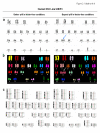Human ESCs predisposition to karyotypic instability: Is a matter of culture adaptation or differential vulnerability among hESC lines due to inherent properties?
- PMID: 18834512
- PMCID: PMC2567976
- DOI: 10.1186/1476-4598-7-76
Human ESCs predisposition to karyotypic instability: Is a matter of culture adaptation or differential vulnerability among hESC lines due to inherent properties?
Abstract
Background: The use of human embryonic stem cells (hESCs) in research is increasing and hESCs hold the promise for many biological, clinical and toxicological studies. Human ESCs are expected to be chromosomally stable since karyotypic changes represent a pitfall for potential future applications. Recently, several studies have analysed the genomic stability of several hESC lines maintained after prolonged in vitro culture but controversial data has been reported. Here, we prompted to compare the chromosomal stability of three hESC lines maintained in the same laboratory using identical culture conditions and passaging methods.
Results: Molecular cytogenetic analyses performed in three different hESC lines maintained in parallel in identical culture conditions revealed significant differences among them in regard to their chromosomal integrity. In feeders, the HS181, SHEF-1 and SHEF-3 hESC lines were chromosomally stable up to 185 passages using either mechanical or enzymatic dissection methods. Despite the three hESC lines were maintained under identical conditions, each hESC line behaved differently upon being transferred to a feeder-free culture system. The two younger hESC lines, HS181 (71 passages) and SHEF-3 (51 passages) became chromosomally unstable shortly after being cultured in feeder-free conditions. The HS181 line gained a chromosome 12 by passage 17 and a marker by passage 21, characterized as a gain of chromosome 20 by SKY. Importantly, the mosaicism for trisomy 12 gradually increased up to 89% by passage 30, suggesting that this karyotypic abnormality provides a selective advantage. Similarly, the SHEF-3 line also acquired a trisomy of chromosome 14 as early as passage 10. However, this karyotypic aberration did not confer selective advantage to the genetically abnormal cells within the bulk culture and the level of mosaicism for the trisomy 14 remained overtime between 15%-36%. Strikingly, however, a much older hESC line, SHEF-1, which was maintained for 185 passages in feeders did not undergo any numerical or structural chromosomal change after 30 passages in feeder-free culture and over 215 passages in total.
Conclusion: These results support the concept that feeder-free conditions may partially contribute to hESC chromosomal changes but also confirm the hypothesis that regardless of the culture conditions, culture duration or splitting methods, some hESC lines are inherently more prone than others to karyotypic instability.
Figures



Similar articles
-
Generation of Sheffield (Shef) human embryonic stem cell lines using a microdrop culture system.In Vitro Cell Dev Biol Anim. 2010 Apr;46(3-4):236-41. doi: 10.1007/s11626-010-9294-2. Epub 2010 Mar 12. In Vitro Cell Dev Biol Anim. 2010. PMID: 20224972
-
Chromosomal spread preparation of human embryonic stem cells for karyotyping.J Vis Exp. 2009 Sep 4;(31):1512. doi: 10.3791/1512. J Vis Exp. 2009. PMID: 19734841 Free PMC article.
-
Autogeneic feeders for the culture of undifferentiated human embryonic stem cells in feeder and feeder-free conditions.Methods Cell Biol. 2008;86:15-28. doi: 10.1016/S0091-679X(08)00002-2. Methods Cell Biol. 2008. PMID: 18442642
-
Human embryonic stem cells and chromosome stability.APMIS. 2005 Nov-Dec;113(11-12):751-5. doi: 10.1111/j.1600-0463.2005.apm_305.x. APMIS. 2005. PMID: 16480447 Review.
-
Human embryonic stem cells and genomic instability.Regen Med. 2009 Nov;4(6):899-909. doi: 10.2217/rme.09.63. Regen Med. 2009. PMID: 19903007 Review.
Cited by
-
Robust protocol for feeder-free adaptation of cryopreserved human pluripotent stem cells.In Vitro Cell Dev Biol Anim. 2019 Dec;55(10):777-783. doi: 10.1007/s11626-019-00413-9. Epub 2019 Oct 29. In Vitro Cell Dev Biol Anim. 2019. PMID: 31664691
-
Roadblocks en route to the clinical application of induced pluripotent stem cells.J Cell Sci. 2010 Mar 1;123(Pt 5):643-51. doi: 10.1242/jcs.054304. J Cell Sci. 2010. PMID: 20164303 Free PMC article.
-
The Impact of Acquired Genetic Abnormalities on the Clinical Translation of Human Pluripotent Stem Cells.Cells. 2021 Nov 19;10(11):3246. doi: 10.3390/cells10113246. Cells. 2021. PMID: 34831467 Free PMC article. Review.
-
Engraftment characterization of risk-stratified AML in NSGS mice.Blood Adv. 2021 Dec 14;5(23):4842-4854. doi: 10.1182/bloodadvances.2020003958. Blood Adv. 2021. PMID: 34470043 Free PMC article.
-
Single cell heterogeneity in human pluripotent stem cells.BMB Rep. 2021 Oct;54(10):505-515. doi: 10.5483/BMBRep.2021.54.10.094. BMB Rep. 2021. PMID: 34488931 Free PMC article.
References
-
- Bueno C, Montes R, García-Castro J, Greaves M, Menendez P. Drug Discovery Today: Disease Models. 2008;4:53–60. doi: 10.1016/j.ddmod.2007.10.004. - DOI
-
- Maitra A, Arking DE, Shivapurkar N, Ikeda M, Stastny V, Kassauei K, Sui G, Cutler DJ, Liu Y, Brimble SN, Noaksson K, Hyllner J, Schulz TC, Zeng X, Freed WJ, Crook J, Abraham S, Colman A, Sartipy P, Matsui S, Carpenter M, Gazdar AF, Rao M, Chakravarti A. Nat Genetics. 2005;37:1099–1103. doi: 10.1038/ng1631. - DOI - PubMed
Publication types
MeSH terms
LinkOut - more resources
Full Text Sources
Other Literature Sources

